Seniors showcase hard work at design expo
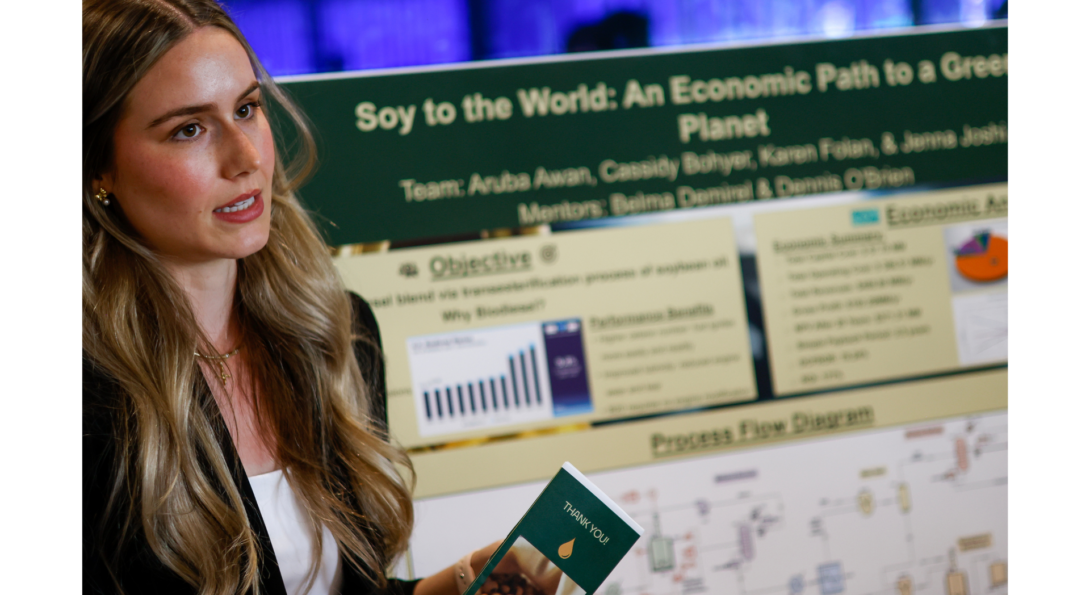
block
People milling about the UIC Credit Union 1 Arena on April 25 saw hundreds of senior design projects on various topics, including the creation of renewable fuels through alternative means.
The chemical engineering seniors also showcased their design projects during the annual Chemical Engineering Showcase on April 28 in the Engineering Innovation Building. Alumni of the department, mentors from the projects, fellow students, and faculty all walked throughout the building’s first floor to learn about the variety of projects students worked on throughout the year.
Here are some of this year’s projects from the chemical engineering department:
block
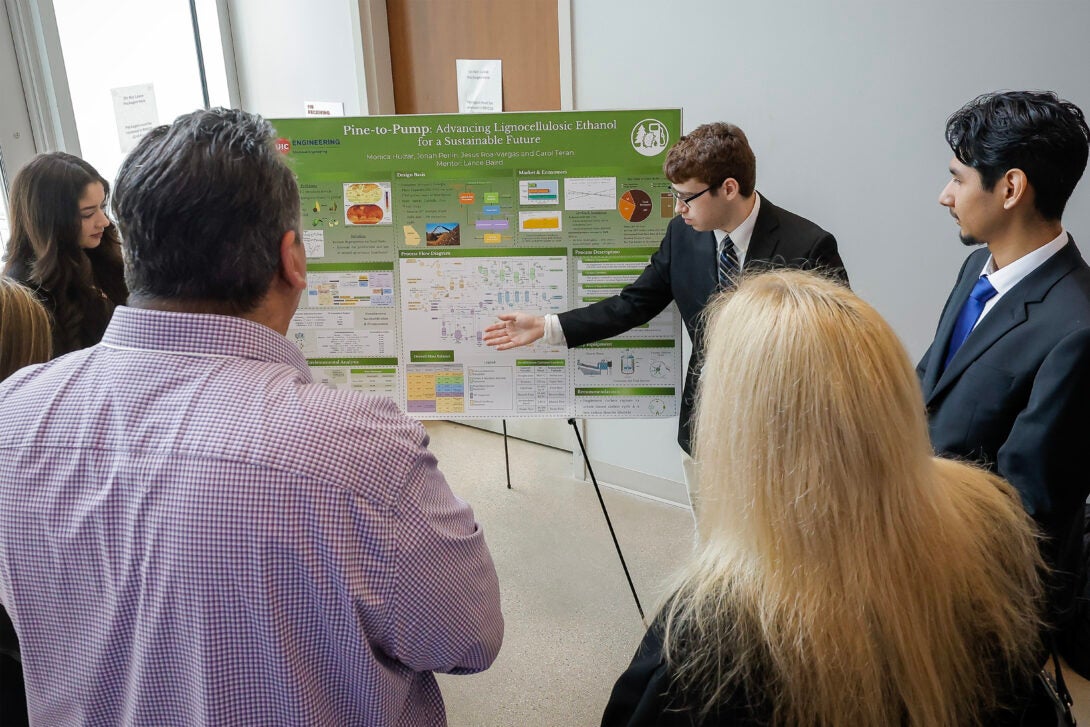
Creating bioethanol fuel through abundant non-food biomass sources
The loblolly pine tree is one of several types of pine trees native to the Southeastern U.S. Its wood is primarily used for lumber, pulpwood, and various other products. The loblolly pine, a type of Southern Yellow Pine tree, is a valuable source of biomass due to its rapid growth and abundance.
UIC Chemical Engineering Department seniors Monica Huizar, Jonah Perlin, Jesus Roa-Vargas, and Carol Teran Huilca designed a simulated commercial-scale facility to produce second-generation bioethanol fuel.
Second-generation feedstock typically comes from non-food biomass sources that contain a plant-based material composed of lignin, cellulose, and hemicellulose, or lignocellulosic biomass, and are not suitable for consumption as they are typically composed of agricultural or municipal wastes, inedible energy crops, cultivated inedible oils, waste oils, and algae.
Most profitable biofuel generation comes from first generation feedstock, including corn, sugar cane, and soy, and is easy to extract. This fact becomes a problem for society as it competes with other food and crops for food.
The group has also been looking into making beer and liquor to create additional profits from the ethanol production. To do this, they’ve looked at other industries including the paper industry to model their own process after.
“We looked into how they gathered their biomass, pretreat it, the bleaching process,” said Roa-Vargas. “But from there we don’t go through the bleaching process test, instead, we go through a fermentation process for the wastewater and followed how distilleries do it. They get their stillage, wastewater, and solids out and whatever was left over from there, we try to create a more economical wastewater treatment for our peat by removing all the solids beforehand.”
The group noted that they enjoyed learning how to deal with solids because their previous classwork has involved mostly studying liquids and gases, but they started implementing solids and slurries. They also delved into the distillation process and a whole recovery session for the solvent.
They also said that they wanted to recover as much product as possible to preserve costs and regenerate their own solvent.
“We enjoyed that as we started trying to simulate the process, we found that our coursework up until now was very beneficial in that we could take what we’ve learned and apply a lot of it to our project ourselves,” Perlin said. “Our mentors also helped in designing our process.”
This group won third place for the Chemical Engineering Senior Design Showcase and their team received $300, sponsored by Honeywell UOP.
block
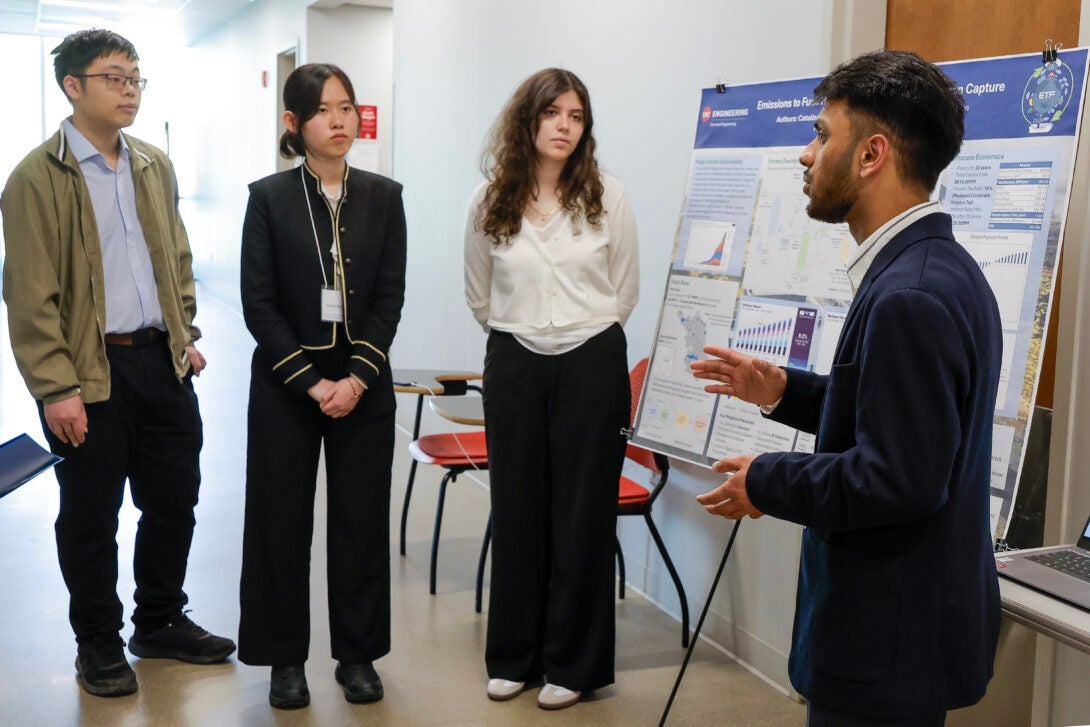
Using carbon capture to create sustainable methanol
According to the U.S. Environmental Protection Agency, in 2022, 60% of electricity produced in the U.S. came from burning fossil fuels, such as coal and natural gas. In turn, this production creates greenhouse gases, which are substances in Earth’s atmosphere that trap heat, contribute to the greenhouse effect and warm the planet.
With the increase in greenhouse gas emissions, industries around the world have pledged to limit global warming by decarbonization. As a step towards decarbonization and combat these emissions, chemical engineering department seniors Catalina Toro Gutierrez, Huyen Nguyen, Varun Maheshwari, and Xiaorun Lin designed a sustainable chemical plant that captures carbon dioxide emissions from coal-fired power plants and converts it into methanol–a versatile fuel with a growing demand as an alternative clean fuel in the shipping industry and as chemical feedstocks.
The plant works by taking flue gas from coal-fired power plants and pushing it through a water wash system to the stripping system, through which one or more components are removed from a liquid stream through contact with a gas stream or another liquid stream. From there, it is cooled and then travels to the carbon hydrogenation reaction that eventually results in methanol production through distillation. The system releases CO2-free gas to the atmosphere as a byproduct as well as water to post treatment and some waste that is disposed of.
Maheshwari added that this project promotes sustainability by capturing CO2 emissions and purposing methanol as a clean alternative fuel, thus minimizing environmental impacts.
The plant is proposed to be based in the Jiangsu Industrial Region in China and engineered to capture roughly 1.21 million metric tons of CO2 per year and synthesize 880,000 metric tons of methanol annually, aligning with China’s “30-60” climate plan and global decarbonization efforts.
“With an attractive economic analysis and a feasible process design, this design demonstrates practical integration of carbon capture and utilization for a circular economy,” said Maheshwari. “This showcases a scalable and economically viable path towards net-zero emissions and sustainable chemical production, welcoming a better future.”
The group won first place for the Chemical Engineering Senior Design Showcase and their team received $500, sponsored by AthenaVisuals Inc.
The group received the Best in Show award for Engineering Expo 2025.
block
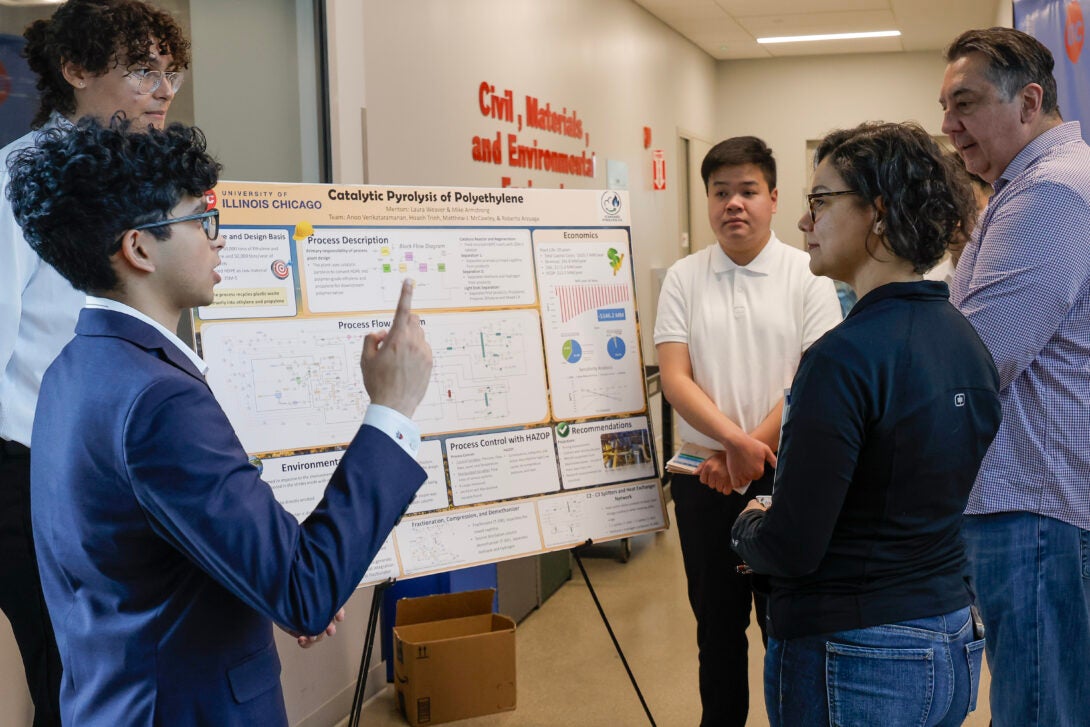
Redesign plastic production
Polyethylene is a widely used thermoplastic polymer in common plastic products such as packaging, bottles, films, and plastic bags. In fact, 460 million tons of plastic is produced annually globally, with almost 350 million tons ending up as waste and about 11 million metric tons ending up in the ocean each year.
Seniors Anoo Venkataramanan, Hoanh Trinh, Matthew McCawley, and Roberto Arzuaga aimed to create a plant that uses catalytic pyrolysis to convert high-density polyethylene into polymer-grade ethylene and propylene for downstream polymerization. The group’s project recycles plastic waste into ethylene and propylene and produce 50,000 tons of ethylene and propylene and 50,000 tons per year of byproducts.
The group’s design was inspired by the environmentally compromising effects of flaring during hydraulic fracture, and they are striving to improve the environmental responsibility of the design. Flaring during hydraulic fracture typically takes place during natural gas production unlike the creation of plastics is done through chemical interactions.
Through heat integration, they plan to reduce large amounts of water being used for cooling water, generate low, medium, and high-pressure stream and use it in distillation column reboilers.
club
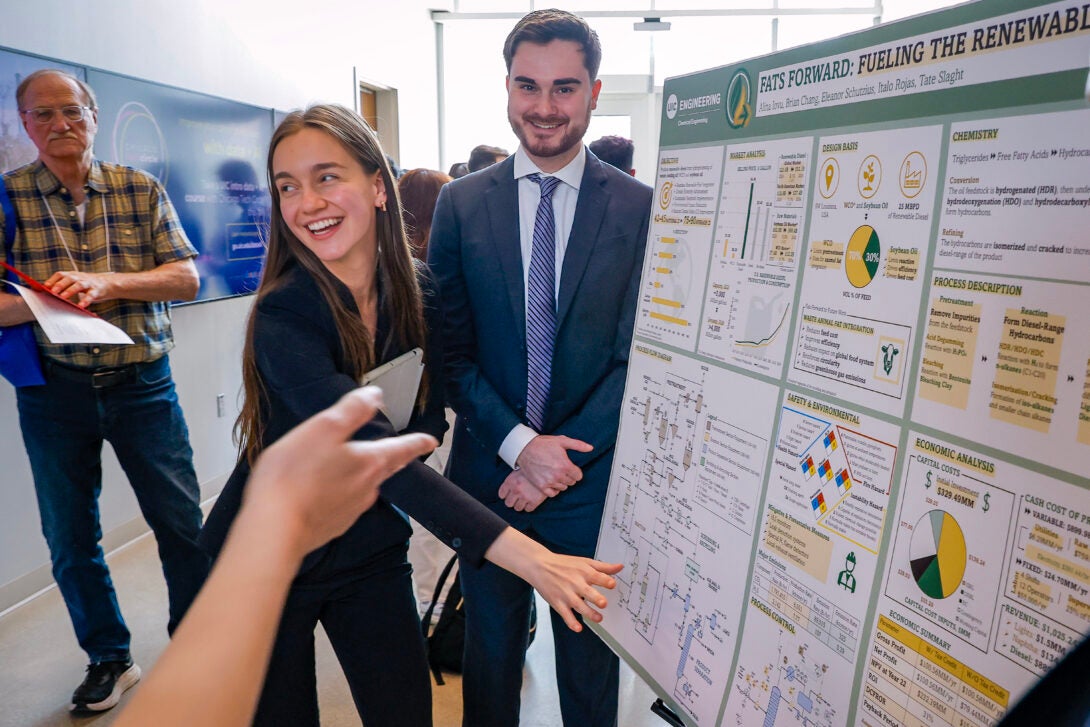
System to take waste cooking oil and convert to renewable diesel fuel
About 15 million tons of waste cooking oil are produced annually around the world. Waste cooking oil is edible oil that has been used for cooking and/or frying and is no longer suitable for consumption.
However, one group of seniors from the UIC Chemical Engineering Department have designed a plant that transforms this waste cooking oil and soybean oil to renewable diesel through hydroprocessing. Hydroprocessing is a refinery process that uses hydrogen gas and catalysts under high temperature and pressure to refine crude oil.
Chemical engineering seniors Eleanor Schutzius, Alina Iovu, Italo Rojas, Tate Slaght, and Brian Chang designed a plant based in southwestern Louisiana that works to create seamless renewable fuel integration, circular economic advancement, sustainable feedstock implementation, environmental impact reduction, and improve how fast the fuel ignites.
The oil, which contains triglycerides, is taken from its feedstock form and is free fatty acids, which then go through hydrogenation, then hydrodeoxygenation, and then hydrodecarboxylation to form hydrocarbons.
The process involves removing the impurities during pretreatment, then the reaction occurs when diesel-range hydrocarbons are formed, and then separation to isolate the diesel and byproducts, and finally scrubbed to clean the product and recycle the hydrogen.
The group found that their facility appears to be technologically and economically feasible.
The group won second place for the Chemical Engineering Senior Design Showcase and their team received $400, sponsored by Brindley Engineering.